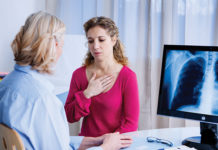
Endometriosis is a common gynaecological condition that is often painful. Symptoms can range from mild to serious, and can include excessive menstrual cramps, bleeding between periods, pain in the lower abdomen and more. If you’ve been diagnosed with endometriosis, there’s no need to feel alone. It affects around 10% of women during their menstrual years. Your lifestyle choices can affect the severity of the disorder, which is why following an endometriosis diet is so important. Take a look at what to eat and avoid if you have endometriosis!
What is Endometriosis?
Endometriosis is a common disorder that occurs when the tissue that normally lines the inside of your uterus (called the endometrium), grows outside it. It may grow on your ovaries, bowel and tissues lining your pelvis, and although rare, can spread beyond your pelvic region. The hormone changes you experience during your menstrual cycle can cause the misplaced endometrial tissue to become inflamed and painful. The tissue grows, thickens and breaks down, getting trapped in your pelvis and causing irritation, scar formation, severe period pain and fertility problems.
What Are The Symptoms of Endometriosis?
The symptoms of endometriosis vary greatly, with some women experiencing mild symptoms, and others with symptoms that wildly affect them. Pelvic pain is the most common symptom of endometriosis, often associated with menstrual periods. Other symptoms include painful periods, pain after sexual intercourse, heavy menstrual bleeding or bleeding between periods, pain in the lower abdomen before or during menstruation, intense cramping, discomfort with bowel movements, and lower back pain. It’s also possible to have no symptoms, which is why regular gynaecological exams are so important.
What Causes Endometriosis?
The exact cause of endometriosis is unknown, however there are several possible explanations of the condition. The first theory is called retrograde menstruation, in which menstrual blood containing endometrial cells flows back through the fallopian tubes and into the pelvic cavity instead of out of the body, sticking to the pelvic walls and organs. Another theory is called induction theory, where hormones or immune factors promote transformation of the cells that line the inside of your abdomen into endometrial-like cells.
Some believe hormones like estrogen may transform embryonic cells into endometrial-like cell implants during puberty, while others believe the lymphatic system may transport endometrial cells to other parts of the body. It’s also possible there could be issues with the immune system that make the body unable to recognize and destroy endometrial-like tissue that’s growing outside the uterus.
Endometriosis and Diet: Is There a Link?
Your diet and food choices can influence the progression of endometriosis, as well as increase your risk of developing it. Your diet can also have an affect on how painful or how well-managed your symptoms are. There are certain foods (including the ones listed below) that can negatively influence endometriosis, so keeping your diet in check is key if you’re dealing with this condition.
6 Foods to Avoid If You Have Endometriosis (And Why)
1. Trans Fats
Foods containing trans fats, such as fried foods, canned frosting, and vegetable shortening, lead to greater inflammation, which can increase the pain and discomfort of endometriosis. In fact, eating high levels of trans fats increases your risk of developing endometriosis by 48 percent.
2. Gluten
Foods that contain gluten can lead to an increase in pain and inflammation inside your body, so if you suffer from endometriosis, try going gluten free. Keep in mind that gluten-free substitutes, such as gluten-free bread and pasta are often refined and contain extra fat and sugar, so try to stick to mostly naturally gluten-free foods like vegetables and lean meats.
3. Red Meat
A high intake of red meat has been linked to an increased risk of endometriosis. Red meat contains a lot of saturated fat, so be sure to limit your red meat intake.
4. Dairy
Dairy such as milk, yogurt and cheese should be limited to help mitigate symptoms of endometriosis. Dairy can lead to inflammation, and products containing growth hormones and antibiotics can worsen the symptoms of the condition.
5. Refined Sugar
Refined sugars such as those found in candy, cakes and cookies can worsen the effects of endometriosis. Sugar leads to inflammation, so it’s best to avoid sweets as much as possible.
6. Caffeine and Alcohol
Caffeine and alcohol both raise estrogen levels, which can worsen the symptoms of endometriosis. Caffeine can also aggravate digestive issues and heighten anxiety that comes along with endometriosis, while alcohol can lead to more painful symptoms.
6 Foods That Fight Endometriosis
1. Dark Leafy Greens
Dark leafy greens such as kale, spinach, and chard have amazing anti-inflammatory powers. They’re also quite high in antioxidants and nutrients that can help fight endometriosis.
2. Foods Rich in Iron
If you experience heavy bleeding during endometriosis, replacing your iron is key. There are two types of iron available in food: heme iron from protein sources and non-heme iron from plant sources. Increase your intake of non-heme iron with foods like leafy green vegetables, nuts and beetroot. Get heme iron from lean meat, eggs and fish.
3. Omega 3 Fatty Acids
Omega 3 fatty acids can reduce endometriosis pain and inflammation. Avoid trans fats and keep saturated fats low. Foods with omega 3 fatty acids include salmon and other fatty fish, tree nuts, seeds and olive oil.
4. Fibrous Foods
Fibre keeps your intestinal tract healthy, and helps the elimination of excess estrogens. Fibrous foods include fruits, vegetables, nuts, seeds, legumes and whole grains.
5. Antioxidant-Rich Foods
Foods rich in antioxidants reduce oxidative stress, as well as combat damage and reduce the symptoms of endometriosis. These foods include berries, leafy green vegetables, broccoli, red cabbage, pecans, artichokes, and beets.
6. Green Tea
Green tea is well-known for its antioxidant agents, helping with pain and inflammation. The compound EGCG that’s found in green tea can limit endometrial cell growth, helping to mitigate your symptoms.
Endometriosis is no fun to deal with, but know that you’re not alone, and that there is help. Try these diet tips and avoid foods that will worsen your symptoms, helping you feel better at times you used to feel your worst!













